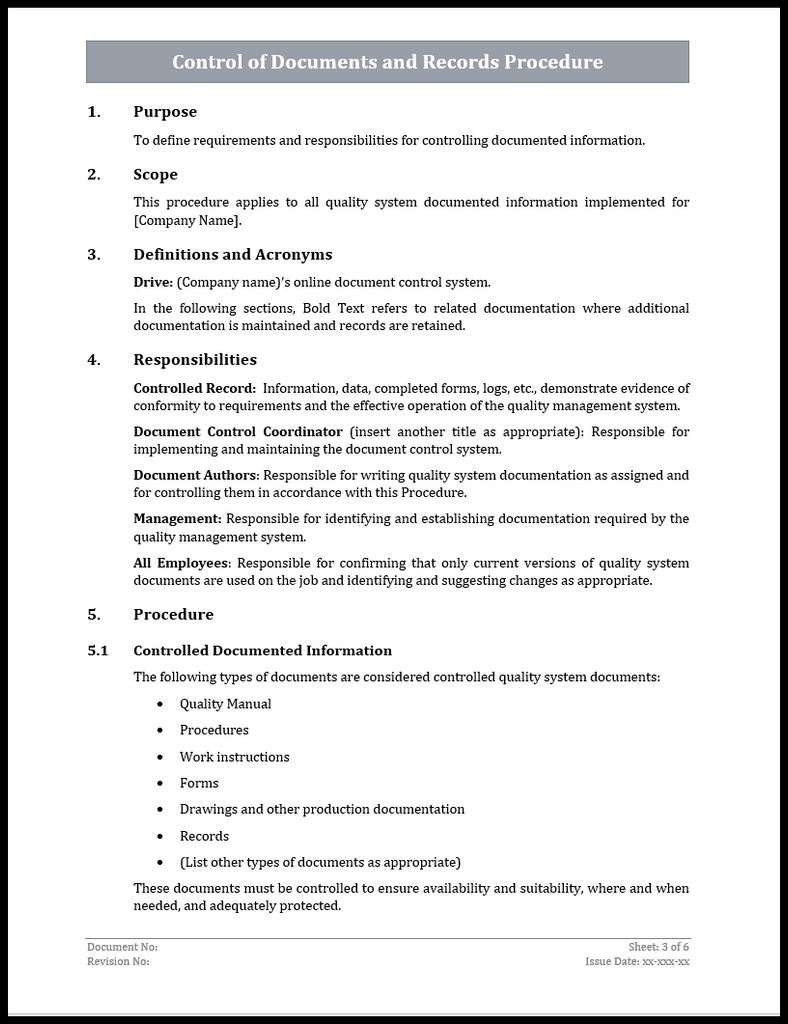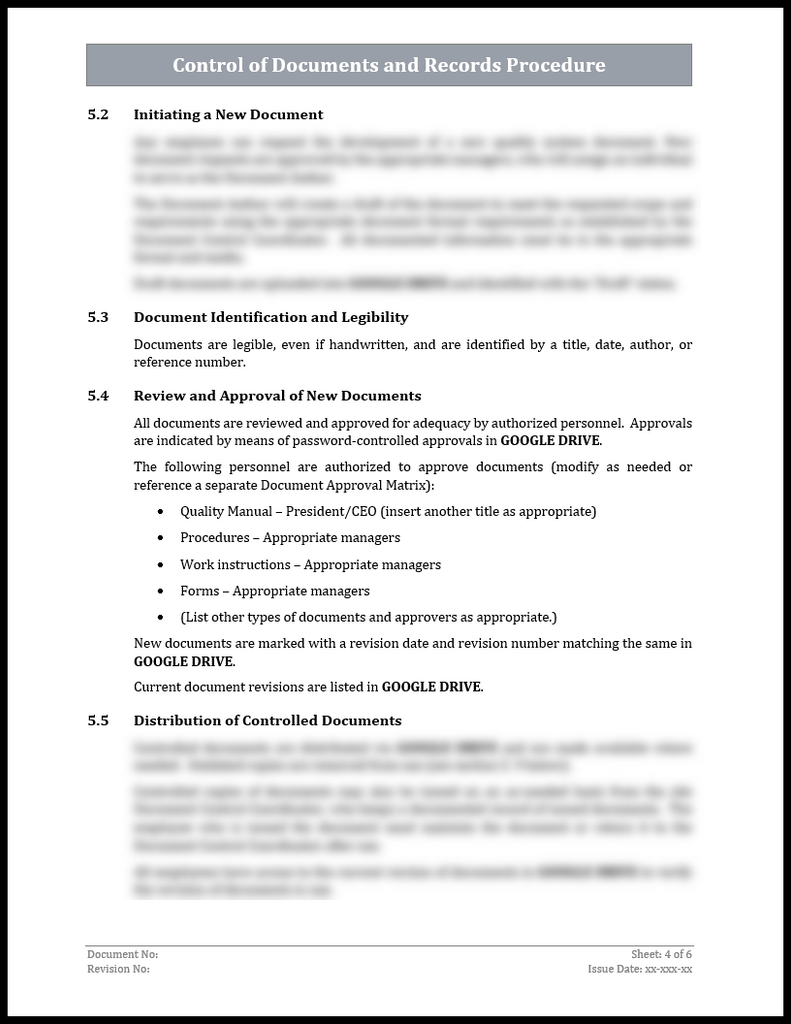ISO 22301 Control of Documents and Records Procedure Template
ISO 22301 is an internationally recognized standard for business continuity management. One of the key requirements of ISO 22301 is the control of documents and records. Effectively managing documents and records is crucial for ensuring the efficiency and effectiveness of business continuity processes.

To help organizations meet this requirement, we have developed an ISO 22301 Control of Documents and Records Procedure Template. This template provides a step-by-step guide to establishing and maintaining an effective control system for managing documents and records related to business continuity. Read on to learn more about this necessary procedure and how it can benefit your organization.
Understanding the Importance of Document and Record Control in ISO 22301
In business continuity management, properly controlling documents and records is paramount. It ensures that important information is readily available when needed and contributes to the overall effectiveness and efficiency of your business continuity processes.
Documents and records are the backbone of any business continuity plan, providing guidance and information for organizations to respond effectively to disruptive events. Without proper control, these documents and records can quickly become outdated or misplaced, rendering them useless in times of crisis.
ISO 22301 recognizes this critical need for document and record control, making it an essential requirement for organizations seeking certification. A robust control system ensures that the proper documents and records are accessible to the right people at the right time.
But how can organizations achieve effective document and record control? This is where our ISO 22301 Control of Documents and Records Procedure Template comes into play. It provides a comprehensive guide to establishing and maintaining a control system that aligns with ISO 22301 requirements.
Utilizing this template can streamline your document and record management processes, ensuring that your organization is fully equipped to handle potential disruptions and maintain business continuity.
In the next section, we will explore the key components of this procedure template and how it can benefit your organization. Stay tuned!
The Key Components of the Control of Documents and Records Procedure
Controlling documents and records is an essential aspect of any business or organization. It ensures that all vital information is appropriately documented, organized, and maintained to support the operations and management of the company. Many businesses utilize a Control of Documents and Records Procedure Template to facilitate this process. This blog post will discuss the key components and functionalities of such a template.
1. Controlled Documented Information:
One of the primary components of the template is the management and control of documented information. This includes any document, record, or data critical to the organization's functions. The procedure template guides the organization in identifying the types of information that need to be controlled and establishes the required protocols for managing and safeguarding them.
2. Document Identification and Legibility:
The template includes guidelines for the identification and legibility of documents. It ensures that each document is uniquely identified, such as using a document number or title, and legible for effective communication and comprehension. These measures help prevent confusion and mistakes from using outdated or unclear documents.
3. Review and Approval of New Documents:
When new documents are created, it is vital to have a systematic review and approval process in place. The procedure template outlines the steps and responsibilities of reviewing and approving new documents before they can be officially circulated or implemented. This ensures that all documents meet the required standards and align with the organization's objectives.
4. Distribution of Controlled Documents:
Efficient distribution of controlled documents is essential to ensure that the right people have access to the correct information at the right time. The template guides the distribution of documents, including delivery methods and appropriate access controls. This helps prevent unauthorized access or distribution of sensitive information, ensuring confidentiality and security.
5. Updating and Re-approving Changes to Documents:
As organizations evolve, documents will inevitably require updates or modifications to reflect these changes accurately. The template outlines the procedures for updating and re-approving documents to maintain relevance and accuracy. This includes establishing a straightforward process for making changes, including version control, revision history, and obtaining necessary approvals before implementing the updated document.
6. External Documents:
Many organizations rely on external documents, including industry standards, regulations, or guidelines. The template should specify how these external documents will be controlled and integrated into the organization's overall document control procedures. This ensures that the organization stays updated with any changes or updates in external documents that may affect its operations.
7. Maintaining Records:
Maintaining records is a critical aspect of document control. The template should outline the necessary procedures for creating, organizing, and preserving records in a secure and accessible manner. It should provide guidelines on how long to retain records, how to dispose of them when no longer required, and any legal or regulatory requirements that must be adhered to.
In conclusion, the Control of Documents and Records Procedure Template is a valuable tool for organizations to establish and maintain effective control over their information and records. By following the guidelines in the template, businesses can ensure that their documents are appropriately managed, up to date, and easily accessible, contributing to operational efficiency and compliance with regulatory requirements.


How to Effectively Implement the Template in Your Organization
Now that you understand the importance of document and record control and how our ISO 22301 Control of Documents and Records Procedure Template can help your organization, let's dive into the process of implementing this template effectively.
1. Familiarize yourself with the template: Take the time to review the procedure template and understand its components thoroughly. This will ensure that you clearly understand the steps involved in establishing and maintaining a robust document and record control system.
2. Customize the template to fit your organization's needs: Every organization is unique, and your document and record control system should reflect that. Tailor the template to align with your organization's requirements, processes, and structure. This customization will enhance the template's effectiveness and relevance to your organization.
3. Communicate and train your employees: Implementing a new procedure requires effective communication and training. Make sure that all relevant employees are aware of the template and its objectives. Provide comprehensive training to ensure everyone understands their roles and responsibilities in the document and record control processes.
4. Monitor and evaluate the system's effectiveness: Once you have implemented the template, regularly monitor and evaluate the effectiveness of your document and record control system. This will allow you to identify any areas for improvement and make necessary adjustments to enhance the efficiency and accuracy of your processes.
By following these steps and utilizing our ISO 22301 Control of Documents and Records Procedure Template effectively, you can establish a robust document and record control system that contributes to the overall success of your business continuity management efforts. In the next section, we will discuss some common challenges that organizations may face during the implementation process and provide tips on overcoming them. Stay tuned!
Benefits of Using the Control of Documents and Records Procedure
Implementing an effective document and record control system is crucial for any organization, especially when achieving ISO 22301 certification. Our Control of Documents and Records Procedure Template offers numerous benefits that can streamline your processes and drive operational efficiency.
1. Standardization: Using our template, you can establish standardized procedures and formats for document creation, review, approval, and retention. This ensures consistency and eliminates confusion throughout your organization.
2. Compliance: The template is designed to align with ISO 22301 requirements, enabling you to meet the documentation and record-keeping obligations mandated by the standard. This reduces the risk of non-compliance and potential penalties.
3. Time and Cost Savings: With a well-defined document control process, you will save time searching for documents and reduce the risk of lost or outdated records. This leads to increased productivity and cost savings in the long run.
4. Improved Quality and Accountability: By implementing this template, you will improve the accuracy, completeness, and availability of your documents and records. This enhances the quality of your outputs and increases accountability throughout your organization.
By utilizing our ISO 22301 Control of Documents and Records Procedure Template, you can experience these benefits and ensure your organization is well-prepared for a smooth ISO 22301 certification process. In the next section, we will provide further guidance on effectively customizing and implementing this template to suit your specific needs. Stay tuned!
Conclusion and Final Thoughts on Maintaining Document and Record Control
In the previous section, we explored the benefits of using our Control of Documents and Records Procedure Template to streamline your processes and achieve ISO 22301 certification. Standardization, compliance, time and cost savings, and improved quality and accountability were highlighted as key advantages.
To fully leverage the benefits of our template, it is essential to customize and implement it to suit your specific needs effectively. This customization involves aligning the template with your organization's existing processes, integrating it into your document management system, and ensuring buy-in from all stakeholders. Regular training and communication should also be conducted to ensure adherence to the procedures outlined in the template.
Maintaining document and record control is an ongoing process. As your organization evolves, you must continuously review and update your procedures to reflect changes in processes, technologies, and regulations. Regular audits and inspections are necessary to ensure compliance and identify areas for improvement.
In conclusion, our Control of Documents and Records Procedure Template is a valuable tool for achieving ISO 22301 compliance. By implementing it effectively and maintaining document and record control, your organization can consistently meet regulatory requirements, enhance operational efficiency, and secure a competitive advantage in the market.


